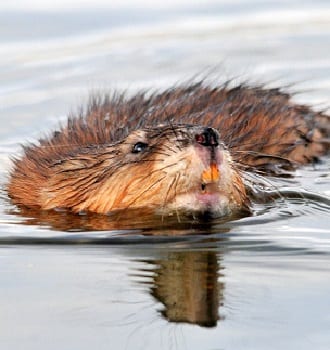Introduction - Muskrat
The Muskrat, who is often referred to as a rat, marsh rabbit, mud beaver, or mud cat, is a medium sized rodent that is not actually a true rat. It is native to North America and can be found in many areas including temperate rainforest. They can also be found in Asia, Europe and South America. They live in areas where water is nearby such as wetlands, mashes, ponds, and rivers. The information below list interesting facts about Muskrats including what they look like, why they spend so much time in the water, and when they breed. This information is written for both kids and adults.Click here for a great selection of Amazon.com books about North American animals.
Basic Muskrat Facts
- It is easy to tell when a muskrat has been on land because the tail drags on the ground leaving a distinct track.
- A Muskrat builds a lodge out of water plants that resembles a Beaver lodge. In addition to the lodge they will also build platforms on which to eat and burrow holes under water with one entrance above the water.
- Muskrats eat their food on the platforms they have made. Their food includes water plants such as water lilies and pondweeds, and living creatures such as crayfish and snails.
- At all times, but especially during breeding season, the muskrat is very territorial. It will go to great lengths to defend its home and its young.
- Muskrats do not hibernate and are active year round. They are primarily nocturnal although they are active during the day as well.
- Muskrats mark their territory by creating a scent post by leaving body fluid on a pile of leaves and grass blades.
- Muskrats are excellent swimmers and can reach speeds of 2-3 miles per hour (3.2 to 4.8 kilometers).
- Muskrats are preyed upon by a number of animals including owls, raccoons, hawks, snapping turtles, Bald Eagles, snakes, as well as dogs, cats, and humans.
- The first litters of Muskrats are born every May, with breeding season starting the month before. Three litters can be born each year with an average of 5-6 kits per litter.
- The young are born without any hair but quickly grow it during the first two weeks of life. Within one month of birth the Muskrats are self-sufficient.
Muskrat Semi Aquatic Life Facts
- The Muskrat is semi aquatic. They are able to stay underwater for long periods of time because carbon dioxide does not affect their bodies the same way it does other mammals. In this way, they are similar to whales and seals. This allows them to remain submerged for 12-17 minutes at a time.
- Muskrats are able to close their ears so water does not enter.
- Muskrats can chew their food while underwater.
- Webbing in between their toes on their hind feet help steer them. Hairless tails with scales help to propel them both forwards and backwards.
Muskrat Characteristics Facts
- The eyes and ears of the Muskrat are small.
- Two layers of dark, short, waterproof fur cover the body to protect the Muskrat from cold water temperatures.
- Adults weigh up to 4 pounds (1.8 kg) and can be anywhere from 23-26 inches (58-66 cm) in length. Their tail is approximately 8-11 inches (20-27 cm) in length.
